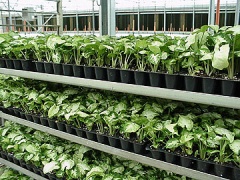Foliage plants
| Infobox on Foliage plants | |
|---|---|
| Example of Foliage plants |  |
| Facts | |
| Origin | - |
| Stowage factor (in m3/t) | - |
| Humidity / moisture | - |
| Ventilation | - |
| Risk factors | See text |
Foliage plants
Contents
Description / Shipment / Storage / Risk factors
Foliage plants
Foliage plants are shipped long distances to supply retail markets throughout North America and Europe. Temperature control is critical to successful shipping and quality retention in the darkness of transport vehicles. The shipping environment is not conducive to maintaining foliage plant quality. Although it is difficult to generalize, the best shipping temperature is in the range of 15°C to 18°C (Table below), with 85% to 90% RH. Temperatures of 10°C to 13°C are the lowest that should be considered for shipping, and even at this range some chilling injury may occur with some plants. Lower than recommended temperatures for many plants will cause chilling injury. This leads to wilting and yellowing of the leaves. Higher than recommended temperatures will increase the amount of ethylene produced by the plant while lower humidities will dry out the plants. An air temperature recorder should be placed in every load to monitor the transit temperature.
Foliage plants should be acclimatised by growers prior to shipment. Acclimatisation is the process of making plants more tolerant to environmental changes during or after shipment. Growers acclimatise plants using lower fertilizer levels and temperatures, and/or reduced light and water during the last 2 to 4 weeks before shipment. Acclimatised plants are better adapted to dark storage in transit and reduced light in stores than non-acclimatised plants. Requirements and length of shipping tolerated vary due to the wide diversity of foliage plants. Shipping temperatures have been identified for some acclimatized plants in temperature-controlled containers. These guidelines are based on simulated shipping tests in darkness.
In simulated shipping tests at 10°C, 13°C, 16°C and 19°C for 1 to 4 weeks in the dark, Schefflera arboricola shipped best at 19°C, Ficus benjamina at 10°C or 13°C, and Dracaena marginata equally well at 13°C, 16°C and 19°C. These plants withstood shipment for 3 weeks without significant loss of quality and for 4 weeks at some temperatures without severe quality reduction. Shefflera plants recovered from dark storage within 17 days after transfer to light. Ficus plants are damaged by holding at 4°C for 6 or more days. Similar chilling injury can occur on many foliage plants at temperatures drop to 7°C for long periods, or to 2°C to 5°C for even short periods. Although a day at 5°C may not damage most foliage plants, severe damage can occur when plants are subjected to cool temperatures over 3 to 5 day transit time. Coleus is very cold sensitive. Dracaena sanderana and Spathiphyllum clevelandii are severely injured after 1 day at 2°C and slightly after 1 day at 10°C. Aglaonema is very intolerant of temperatures <10°C. Exposure to 4,4°C for 2 days causes severe damage to Scindapsus pictus and Maranta leuconeura. Fittonia verschaffeitii is severely damaged within 8 hours at 2°C.
Foliage plants should be turned over rapidly in marketing and should never be over-ordered. Plants should not be stored in back rooms for extended periods or in severe drafts of heat or cold. Foliage plants should not be transported with fruits, vegetables, or cut flowers, most of which emit ethylene and are shipped at low temperatures. Plants such as Scheffleras, Crassulas, Fittonias, and Ficuses are very sensitive to ethylene at a level as high as 5 ppm.
Suggested shipping temperatures for acclimatized foliage plants to maintain quality in refrigerated containers
| Plant name | 1 - 15 days shipment C | 16 - 30 days shipment C2 | |
Aglaonema, cv. Fransher Aglaonema, cv. Silver Queen Ardisia crispa Aspidistra elatior Brassaia actinophylla Chamaedorea elegans Chaemaedorea seifrizii Chrysalidocarpus lutescens Codiaeum variegatem Cordyline terminalis Dieffenbachia picta











